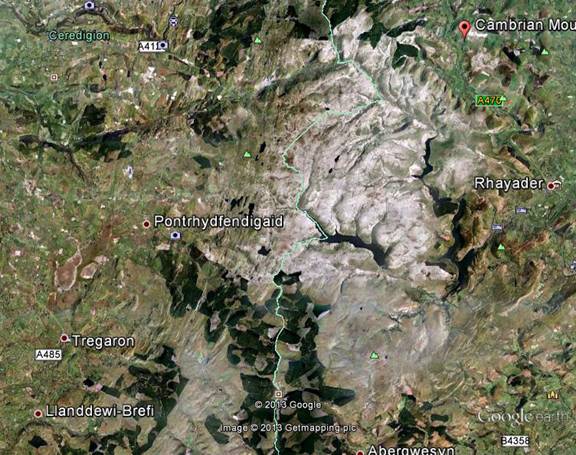
Google earth roughly 52o 18’ North 3o 42’ West downloaded May 15, 2013
New light coming on Cambrian biological diversity:
Behold the Cambrian Mountains of Wales.

Google earth roughly 52o 18’ North 3o 42’ West downloaded May 15, 2013
There are a couple or three things of interest here. First you can notice the layered appearance. The geography of Great Britain is to a first approximation the same as just about everywhere; the older layers lie beneath newer ones. But here, more than anywhere else, the layers are tilted. As one moves to the east and to the south the surface is steadily younger and younger rock. This fact is said (Simon Winchester The Map that Changed the World Harper Collins 2001) to contribute to the interest of English Villages. They were built of local stone so that each village looks different from others just a few miles away.
The rocks of the Cambrian mountains contain the oldest fossils of complex life, and it is after these rocks that the Cambrian era of life was named. Silly old me. I had thought it was named after the rocks around Cambridge, about 160 miles to the east. If that were true most of England would be devoid of fossils, which is in dramatic contrast with the truth, so the idea that the Cambrian Age was named after Cambridge never did many any sense.
The origin of life has been and remains a mystery. They keep finding older and older things that look like primitive life forms so one begins to suspect that primitive life arose about as soon as the earth’s climate was suitable. Some of the most ancient forms now found are in places like hot springs and thermal vents, places that seem quite forbidding to us. In contrast the fresh air and sunlight we find so bracing are toxic to ancient forms.
While life may be a predictable event given a suitable environment, complex life is a very different matter. Suddenly all sorts of life turned up more or less all at once.
I have mentioned that I think I know why. Complex life can only arise through evolution (peace, those who doubt, but attend), evolution can only progress if there is speciation (as pointed out by Alfred Rusel Wallace and quite neglected by his contemporary the darling of evolution believers, Charles Darwin), and speciation can only exist or is exceedingly restricted in sexually reproducing life forms if there is a robust safeguard against a mating pool growing too large (as pointed out by moi). So of course I am interested in the Cambrian explosion of complex life.
I am not alone. (Kingdom Come ECONOMIST vol. 406 no. 8828 March 23, 2013 page 83)
In China a team led by Zhu Maoyan are studying fossils around the time of that Cambrian explosion. It has long been known that prior to that time life existed but was quite simple in form. In Cambrian times life was very complex, and the change was rapid.
What the Chinese are doing is comparing the timing of the emergence of complex life with geological changes about the same time. Perhaps geologic events were prodding life into moving along toward more complexity and perhaps the chemical activity of life was altering geology and quite likely both.
I am sure there will be answers forthcoming. And I am morally certain that my own notion about population sizes will not come tumbling out of the data; the possibility will not be considered. But there is no hurry. Those fossils have been there for a long time. The area of relevant geology in China is large. There will be plenty of time to check out whether the emergence of a mechanism to contain population sizes is helpful in explaining what is found in the ground.
There have been 91 visitors over the past month.